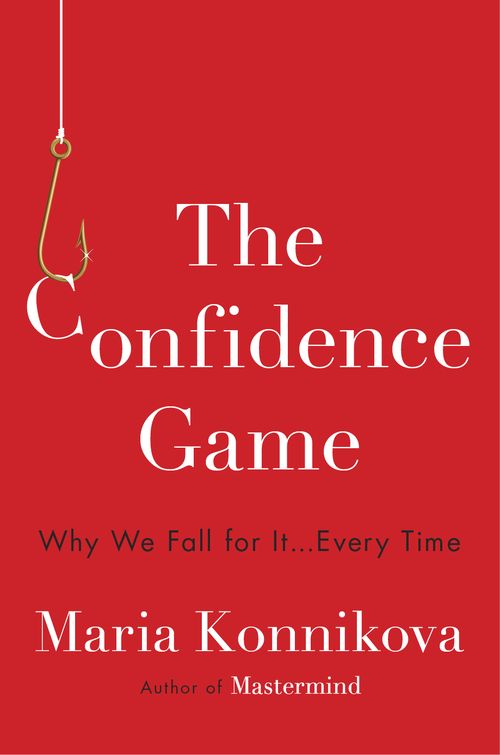
The Confidence Game
Why We Fall for It . . . Every Time
کتاب های مرتبط
- اطلاعات
- نقد و بررسی
- دیدگاه کاربران
نقد و بررسی

Starred review from October 26, 2015
Konnikova (Mastermind) opens a door to the fascinating world of truly brilliant con artists—not the quotidian hustlers, but the Madoffs of the world. She asks whether they are psychopaths, epic narcissists, or just regular Joes with extraordinary confidence and a skill for telling a good story. Konnikova provides a fascinating glimpse into the lives of some of recent history’s smoothest talkers, covering the setups and executions of some of their extraordinary scams. From consumer fraud and online scams to complex, multiyear grifts and bald-faced lies, readers are reminded that these scams could happen to anyone and are far more common than is commonly realized—no one, after all, wants to admit to having been duped. As for why people fall for these cons, Konnikova shows that it’s because humans want to believe great stories and don’t necessarily recognize the fine line between a legitimate story and an illegitimate one. Told with vigor and enthusiasm, this study of the psychology of the con artist
is riveting and cleverly told. Agent: Seth Fishman, Gernert Company.

Starred review from October 15, 2015
What makes a con artist, and why are we duped by them? New Yorker columnist Konnikova (Mastermind: How to Think Like Sherlock Holmes, 2013) takes us deeply into the art and psychology of the con game. They are known as "confidence artists," a term first applied in 1849 to William Thompson, who befriended New York passers-by before asking them, "Have you confidence in me to trust me with your watch until tomorrow?" The con game existed long before Thompson (or Manhattan, for that matter), and it continues today in Ponzi schemes, e-ticket scams, and missives from Nigerian princes. Konnikova dissects the con into its component stages, illustrating each with accounts of con artists whose mastery made them legend and sent their victims to the poorhouse: Cassie Chadwick, who for years posed as the illegitimate daughter of Andrew Carnegie; Greenwich Village psychic Sylvia Mitchell, who cleaned out customers' bank accounts as "Zena the Clairvoyant"; Victor Lustig, the man who twice sold the Eiffel Tower; and many more. She reveals the inner workings of well-known cons and provides insight into techniques such as information priming and the Marc Antony gambit. Konnikova studies the psychology of both the grifter and the mark, laying bare what makes each well-suited for the roles they play in the confidence game. In uncovering the characteristics of a con artist, the author points to a "dark triad" of traits: psychopathy, narcissism, and Machiavellianism. She examines the roots of both deception and trust, and she explores a range of behaviors and attributes that include the chameleon effect (why Dale Carnegie's treatise on winning friends and influencing people is "a sort of unwitting bible for cons in training"), the inherent human belief in positive outcomes, and the sunk-cost fallacy, a tendency that keeps us clinging to an investment despite glaring signs that we should walk away. With meticulous research and a facility for storytelling, Konnikova makes this intriguing topic absolutely riveting.
COPYRIGHT(2015) Kirkus Reviews, ALL RIGHTS RESERVED.

December 1, 2015
Everyone has the potential to be conned, posits Konnikova (contributing writer, The New Yorker; Mastermind); no matter how intelligent and wary they are, everyone has their weak spot. The author explains how con artists do what they do and why it works. The book dissects the various parts of the con, gives examples of each part, and cites psychological studies into why they work. For example, when discussing "the play," when a victim is first hooked, the author notes that persuasive stories are often used instead of facts and data because of their emotional effect and difficulty to refute: "Facts are up for debate. Stories are far trickier." Each section features accounts that provide interesting illustrations as well as studies of the psychological elements at work, often with further academic discussion. Konnikova presents a thorough and engaging investigations of the elements of a con and why such people still succeed no matter how invulnerable we think we are to them. VERDICT This book provides just enough personal narratives and studies to hold the attention of the layperson with a curiosity about the subject, but the heavier discussions and psychological jargon, though well defined, make it ideally suited for those in the psychology or sociology fields.--Stacy Shaw, Orange, CA
Copyright 2015 Library Journal, LLC Used with permission.

























دیدگاه کاربران